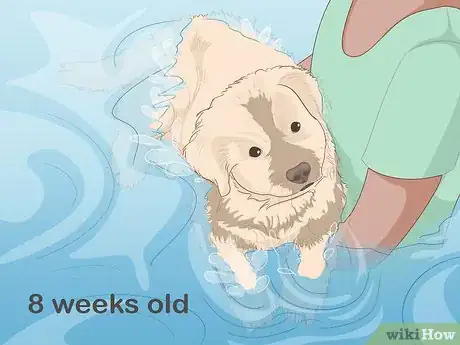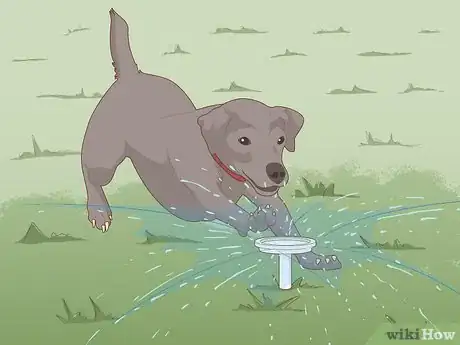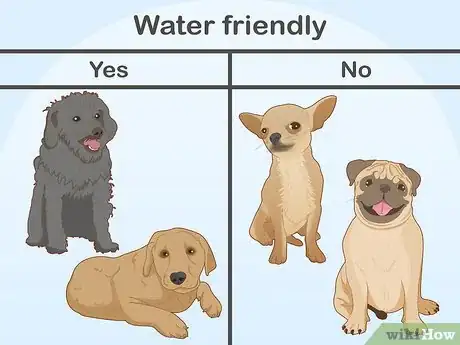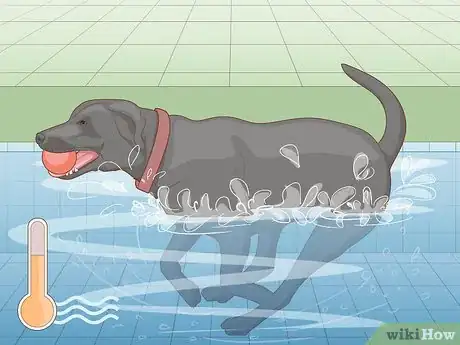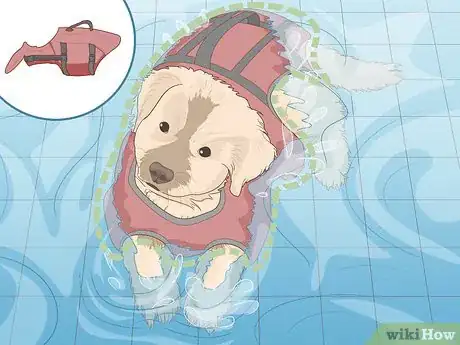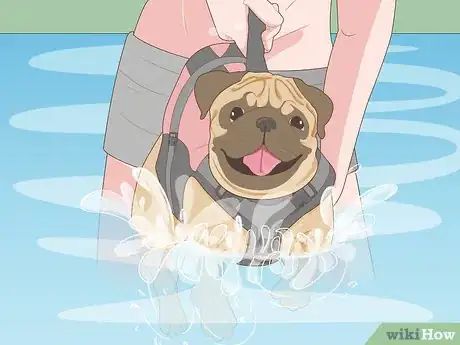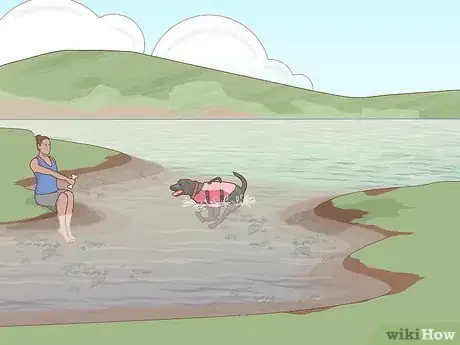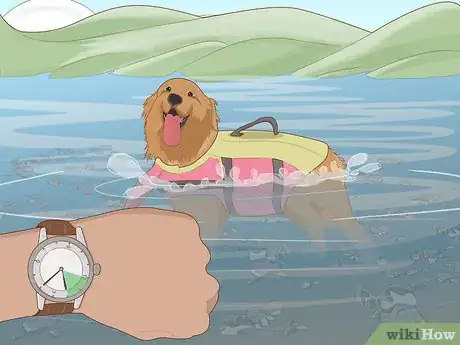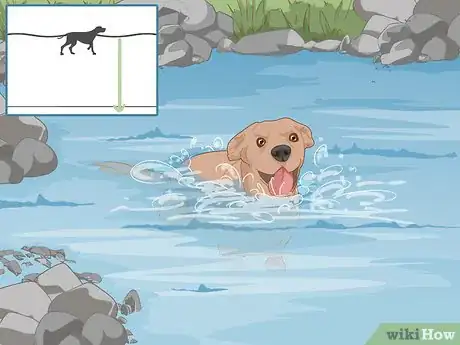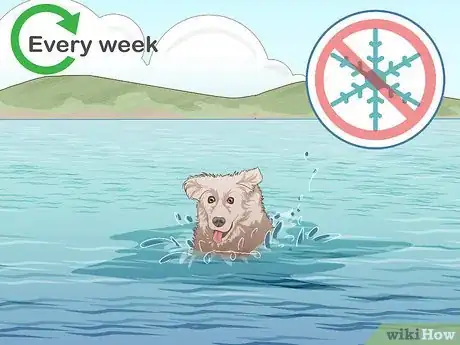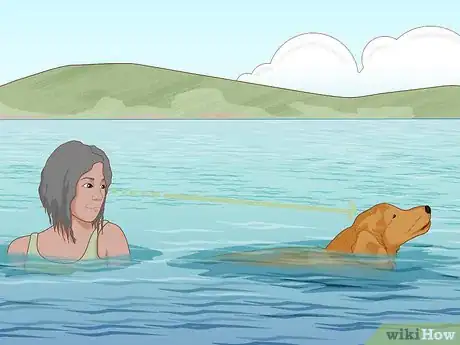This article was co-authored by Belgin Altundag. Belgin Altundag is a Certified Dog Trainer and the Owner of Happy Doggies Day Care/Day Camp in West Hollywood, California. A passionate animal lover, Belgin is knowledgeable about multiple training styles, including obedience training, problem-solving, activity training, and behavior modification. In addition to being an Animal Behavior College’s Certified Dog Trainer (ABCDT), Belgin has also completed the Training Cesar's Way Fundamentals of Dog Behavior and Training Programs 1 and 2 and is certified by the American Red Cross in Cat and Dog First-Aid.
There are 7 references cited in this article, which can be found at the bottom of the page.
This article has been viewed 80,196 times.
Many dogs love the water and become great swimmers over time. However, to get your dog to that point, you need to begin by introducing your dog to the water safely and positively. This introduction should begin when your dog is young, should only consist of positive reinforcement that builds your dog's love of the water, and should include a variety of safety precautions to keep your dog safe. If you start early and make the water fun for your dog, while keeping a close eye on its safety, you could have an expert swimmer sooner than you think.
Steps
Preparing Your Dog
-
1Train your dog to come when called. It is very important that when you put a dog in the water it will respond to your commands. A dog won't always see dangers or problems in its path in the water, so you need to be guaranteed that it will follow your command when called if you spot a hazard. This will help to assure its safety and will make its swimming time less stressful for you as well.
- Even if a dog is on leash while it is swimming, which is should be when it first learns, it should still be trained to come to you when you tell it to. You shouldn't have to drag it back through the water by a leash, as this is dangerous for the dog.
-
2Introduce your dog to water early. While it is important to have a dog well-trained before you take it swimming, getting your dog used to water in general should happen much earlier. Start getting your puppy used to water when it is about 8 weeks old. This is usually when you will bring a puppy home if you have gotten the puppy from a reputable breeder.[1] [2] [3]
- Getting a young puppy used to water as a concept early will make the transition to swimming much, much easier.
- You should introduce your puppy to water by letting it walk around in an inch or two of water, not any deeper, while you closely supervise.
- Letting small puppies watch adult dogs in water can also peak their interest. This will show them that swimming is a natural part of life.
Advertisement -
3Make water fun. Give your puppy a shallow bowl of water to play with or set up a sprinkler in the yard on a hot day and let it run around in it. Whatever you can do to build a positive association with water early on, do it.[4]
- One reason that some dogs shy away from water is that they have a negative association with it. So, one of the best things you can do to safely introduce your dog to water is to increase their interest in it and decrease their fear of it at an early age.
-
4Establish reasonable expectations. Some dogs really are born swimmers. They take to the water immediately and look like they were born swimming. Some dogs are not. If you have a dog breed that is known for swimming, such as a Labrador retriever or a Portuguese water dog, then you can expect that the dog will become an excellent swimmer. However, if you have a dog with very short legs that is not known for it athleticism, such as a Chihuahua or a Pug, then the likelihood that it will be a great swimmer is much slimmer.[5]
- If you have a dog that will probably not be a great swimmer, it's still important to introduce them to the water and make sure they can keep afloat. This is key for their safety and they may even enjoy the water, even if they are not that good at navigating it.
Introducing Your Dog to Swimming
-
1Start in very shallow, warm water. When your dog is two to five months old, you can start to teach your dog to swim. At that age it will have the strength and endurance necessary for its first swimming lessons. Do not throw a dog that is new to water into deep, cold water and expect it to automatically swim. Instead, you need to allow the dog to go through a gradual learning process, much the way humans need to gradually learn to swim.[6]
- Let your dog spend a lot of time playing and having a good time in shallow water that is at a comfortable temperature before you introduce it to deeper water. This will give it good associations with water to begin with.[7]
- Spend time in shallow water playing your dog's favorite game. This could be simply running and sniffing around or it could be a game of fetch, whatever your dog loves to do.
- There are some dogs that are better at swimming than others. This can be about the individual dog but swimming skills also tend to fall along breed lines.
-
2Use a flotation device. If you are worried about your dog's safety, you can put a life vest on it to make sure it doesn't drown. There are a wide variety of canine flotation devices on the market that are designed to keep a dog safe while it is enjoying the water. These are usually vest-type jackets, that hook around the dog's chest and under its belly.[8]
- Just like flotation devices for humans, it is important that you get one for your dog that fits it perfectly. A snug fit is important when it is keeping your dog afloat.
- Canine flotation devices often have a handle on the back so that you can more easily grab your dog out of the water if it is having trouble or you simply want to get it out of the water.
- Putting a flotation device on an older dog that is having mobility issues is also a good way to allow them to continue to enjoy the water without the fear that they will become exhausted and drown.
-
3Enter the water with your dog. Don't assume that you can tell your dog to go into the water alone and it will go. Instead, it may need some encouragement and support in the form of you going in with it.[9] Carry a timid dog into the water and show it that you are there to help it. Hold onto the dog and let it do a few paddles with its paws while you continue to hold it.[10]
- Expect to go into the water with your dog multiple times before the dog is comfortable with deep water.
- Hold onto the dog tightly if it is scared and don't force it to paddle without support.
- If you hold the dog around its midsection, it will be able to paddle with its front and back paws while still getting support from you.
- Be prepared for the dog to struggle. Hold onto it, preferably with a harness or flotation device, so that it doesn't get away from you if it panics.
-
4Allow the dog to swim to shore. Don't force a dog that wants to get out of the water to stay in the water. This will only make the dog more skittish of the water in the future. However, have it swim a short distance in order to get out of the water.
- Swimming a short distance to shore is good practice at swimming for the dog. Keep a close eye on it while it is swimming and be sure to help it if it looks like it is struggling.
- It is helpful to have a friend on the shore who can call the dog. If you are out in the water with the dog, your friend can call it to shore and hold up a treat, coaxing it to swim on its own.
-
5Train for short periods of time. Learning to swim can be very exhausting for a dog, as it uses a new array of muscles and a lot of calories to stay afloat. If your pup looks tired or is panting excessively, take a long break or call it a day.[11]
- This amount of time your dog should swim while learning will vary, depending on your specific dog. Keep a close eye on your dog and err on the side of caution when ending your dog's swimming lessons.
Building Your Dog's Skills
-
1Work your way up to larger bodies of water. It can be very intimidating to a dog that is new to swimming to enter a large body of water, even if it is ready to doggy paddle. Instead, work your way up to a depth that your dog cannot touch the bottom of by getting your dog to enter a smaller body of water that is deep, such as a deep pond.
- Not being able to touch the ground when you are close to the edge, and thus close to safety, is much easier than having a long way to swim if you get into trouble.
-
2Make swimming a regular part of life. Like most skills, your dog will get better and better at swimming the more it does it. If you want to make your dog a great swimmer, perhaps because you want to use it as a hunting dog or you do a lot of activities in the water yourself, then you need to build its skills on a regular basis.[12]
- Make it a habit to take your dog to a river or lake for swimming on a weekly basis while you are teaching it to swim. This regular practice will improve its skills dramatically.
- However, keep in mind that a dog should not be swimming in frigid waters, so you may need to keep it out of the water in the winter. Water that is too cold can give the dog hypothermia and can easily cause it to drown due to shock to its system.
-
3Keep a close eye on the dog. Don't assume that just because your dog is initially doing well in the water that it does not need supervision. All dogs that are swimming need supervision, whether it is just learning or is a skilled swimmer.[13]
- A dog that is new to the water is likely to tire quickly, as it is using new muscles and is doing a new activity that takes a lot of stamina. Your dog could go from happy to being in trouble very quickly, so you need to be on the lookout for this change.
- Keeping control of a dog while it is learning to swim is important. This means that you should have a hold on the dog, ideally with a harness, while it tests the waters so that you can save it if it gets into trouble.
Expert Q&A
-
QuestionShould I throw my dog in the water?
 Belgin AltundagBelgin Altundag is a Certified Dog Trainer and the Owner of Happy Doggies Day Care/Day Camp in West Hollywood, California. A passionate animal lover, Belgin is knowledgeable about multiple training styles, including obedience training, problem-solving, activity training, and behavior modification. In addition to being an Animal Behavior College’s Certified Dog Trainer (ABCDT), Belgin has also completed the Training Cesar's Way Fundamentals of Dog Behavior and Training Programs 1 and 2 and is certified by the American Red Cross in Cat and Dog First-Aid.
Belgin AltundagBelgin Altundag is a Certified Dog Trainer and the Owner of Happy Doggies Day Care/Day Camp in West Hollywood, California. A passionate animal lover, Belgin is knowledgeable about multiple training styles, including obedience training, problem-solving, activity training, and behavior modification. In addition to being an Animal Behavior College’s Certified Dog Trainer (ABCDT), Belgin has also completed the Training Cesar's Way Fundamentals of Dog Behavior and Training Programs 1 and 2 and is certified by the American Red Cross in Cat and Dog First-Aid.
Certified Dog Trainer Definitely not! Make sure that your dog feels comfortable, and that they know where the entrance and exit are. If a dog falls in the water, they'll try to climb out the same way that they came in.
Definitely not! Make sure that your dog feels comfortable, and that they know where the entrance and exit are. If a dog falls in the water, they'll try to climb out the same way that they came in. -
QuestionHow do you introduce a dog to a pool?
 Belgin AltundagBelgin Altundag is a Certified Dog Trainer and the Owner of Happy Doggies Day Care/Day Camp in West Hollywood, California. A passionate animal lover, Belgin is knowledgeable about multiple training styles, including obedience training, problem-solving, activity training, and behavior modification. In addition to being an Animal Behavior College’s Certified Dog Trainer (ABCDT), Belgin has also completed the Training Cesar's Way Fundamentals of Dog Behavior and Training Programs 1 and 2 and is certified by the American Red Cross in Cat and Dog First-Aid.
Belgin AltundagBelgin Altundag is a Certified Dog Trainer and the Owner of Happy Doggies Day Care/Day Camp in West Hollywood, California. A passionate animal lover, Belgin is knowledgeable about multiple training styles, including obedience training, problem-solving, activity training, and behavior modification. In addition to being an Animal Behavior College’s Certified Dog Trainer (ABCDT), Belgin has also completed the Training Cesar's Way Fundamentals of Dog Behavior and Training Programs 1 and 2 and is certified by the American Red Cross in Cat and Dog First-Aid.
Certified Dog Trainer Take it slow. Guide them to the pool stairs and hang out there for awhile. This way, your dog will start to feel more comfortable and familiar with the area.
Take it slow. Guide them to the pool stairs and hang out there for awhile. This way, your dog will start to feel more comfortable and familiar with the area. -
QuestionWhy do some dogs like water and some don't?
 Belgin AltundagBelgin Altundag is a Certified Dog Trainer and the Owner of Happy Doggies Day Care/Day Camp in West Hollywood, California. A passionate animal lover, Belgin is knowledgeable about multiple training styles, including obedience training, problem-solving, activity training, and behavior modification. In addition to being an Animal Behavior College’s Certified Dog Trainer (ABCDT), Belgin has also completed the Training Cesar's Way Fundamentals of Dog Behavior and Training Programs 1 and 2 and is certified by the American Red Cross in Cat and Dog First-Aid.
Belgin AltundagBelgin Altundag is a Certified Dog Trainer and the Owner of Happy Doggies Day Care/Day Camp in West Hollywood, California. A passionate animal lover, Belgin is knowledgeable about multiple training styles, including obedience training, problem-solving, activity training, and behavior modification. In addition to being an Animal Behavior College’s Certified Dog Trainer (ABCDT), Belgin has also completed the Training Cesar's Way Fundamentals of Dog Behavior and Training Programs 1 and 2 and is certified by the American Red Cross in Cat and Dog First-Aid.
Certified Dog Trainer Breed can play a part, but it really comes down to personality. A calm, confident dog might feel okay by the water, while an insecure, needy dog might not feel as comfortable.
Breed can play a part, but it really comes down to personality. A calm, confident dog might feel okay by the water, while an insecure, needy dog might not feel as comfortable.
References
- ↑ http://kb.rspca.org.au/How-old-should-a-puppy-be-before-they-are-adoptedpurchased_311.html
- ↑ http://www.clickertraining.com/node/645
- ↑ http://www.outdoorlife.com/blogs/gun-dogs/2012/06/how-introduce-pup-water
- ↑ http://www.outdoorlife.com/blogs/gun-dogs/2012/06/how-introduce-pup-water
- ↑ http://www.vetstreet.com/our-pet-experts/which-dog-breeds-love-or-loathe-the-water-we-asked-readers-and-experts
- ↑ Belgin Altundag. Certified Dog Trainer. Expert Interview. 15 July 2021.
- ↑ http://www.clickertraining.com/node/645
- ↑ http://www.iaamb.org/acwt/how-to/canine-flotation-devices.html
- ↑ Belgin Altundag. Certified Dog Trainer. Expert Interview. 15 July 2021.
- ↑ http://www.petmd.com/dog/training/evr_dg_how_to_teach_your_dog_how_to_swim
- ↑ Belgin Altundag. Certified Dog Trainer. Expert Interview. 15 July 2021.
- ↑ http://www.outdoorlife.com/blogs/gun-dogs/2012/06/how-introduce-pup-water
- ↑ Belgin Altundag. Certified Dog Trainer. Expert Interview. 15 July 2021.
About This Article
To safely introduce your dog to water, get your puppy used to water early by letting it play in a container with an inch or two of water in it. Alternatively, turn on the water sprinkler in the yard on a hot day and let it play in the water. Before you introduce it to larger bodies of water, make sure your dog responds to the “come” command so you can call it to you if it gets into difficulty. Once it's between 2 and 5 months old, play games with it, like fetch, in shallow warm water so it develops a positive association with the water. If you’re concerned about your dog drowning, consider putting a canine life vest on it to keep it afloat. For tips from our Veterinary co-author on how to teach your dog to swim, read on!

